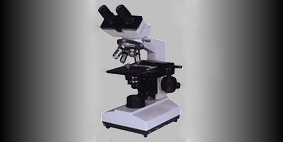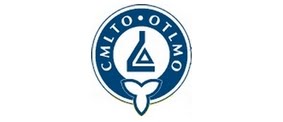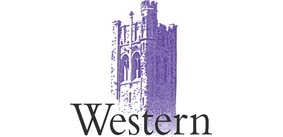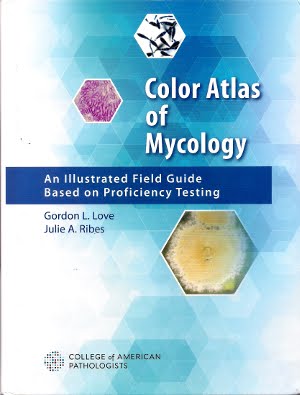Microsporum audouinii (fungus - dermatophyte)
Ecology: Microsporum
audouinii is a cosmopolitan anthropophilic dermatophyte which is spread
person to person. Now rarely seen in
North America or Europe however it remains the most common cause of human
ringworm, primarily
tinea capitis (scalp infection) on the African continent. Travelers and migrant workers may bring this
infection from endemic areas.
M.audouinii infection is more prevalent in
prepubescent children. Hairs will fluoresce
under a ultra-violet Wood’s Lamp.
Macroscopic
Morphology: On Sabouraud-Dextrose
agar the colonies grew with a moderately rapid pace. Colonies were rather flat and spreading with
a radiating margin. They appeared to
have a greyish-white to tan to beige colouration with the reverse a salmon
colour to rose-brown.
M.audouinii on SAB at 3 weeks
* (reverse shown below right)
*Correction: This appeared to be very luxuriant growth for a Microsporum to have developed in only 10 days as I had originally stated. On reviewing my original files I see that this culture was incubated on SAB/SDA at 30ᵒC. (mea culpa)
May 2nd, 2016: I've added another photograph from my files of M.audounii on Sabouraud Dextrose Agar (SAB or SDA, if you prefer) incubated at 30ᵒC for 14 days. As you can see, the growth is much more sparse that that above. I'm not sure what my thought process was some four years ago when I originally posted the culture photo.
M.audounii on SAB (SDA) incubated at 30ᵒC for 14 days (Nikon)
* * *
.jpg) Microscopic
Morphology:
Microscopic
Morphology: Hyphae are septate and
often show pectinate (comb-like) and racquet cells (See photo). Both intercalary (in the middle of a hyphae)
and terminal (at the end of a hyphae) chlamydospores may be present. Terminal chlamydospores may have a small
point or peak at their apical end.
Sources report that microconidia and macroconidia are rare. Microconidia are ovoidal to clavate (club
shaped). Macroconidia can be elongated
or spindle shaped and may be irregular or distorted in their shape. They may also show a slight constriction
along their length often closer to the center.
The macroconidia are thick-walled, variable in size (30-80 µm X
8-14 µm)
and number of internal cells. They are
usually echinulate (small spiny like projections on surface) to some degree.
Photos below were taken with the Nikon Coolpix camera or the Leica DMD-108 Digital Microscope as indicated. Read more about the photography in the post entitled 'Toys'.

M.audouinii hyphae bearing microconidia (LPCB X 400 -Nikon)
(authoratative sources state that microconidia are rare however the isolate I'm presenting here seems to be capable of producing ample numbers.)
M.audouinii - photo just to show the septate hyphae (S) and microconidia (M)
M.audouinii - starting the formation of racquet hyphae which appear somewhat like a tennis racquet, narrower on one end and wider-round on the opposite end usually stacked in greater numbers than in my photo. (LPCB X1000
DMD-108)
M.audouinii - what appears to be racquet hyphae though not "text-book" in shape.
(LPCB X1000)
As above
M.audouinii -Pectinate hyphae (comb-like structure of hyphae)
(LPCB X1000)
M.audouinii -Pectinate hyphae (comb-like structure of hyphae)
(LPCB X1000)
M.audouinii - another example of pectinate hyphae (LPCB X1000
DMD-108)
M.audouinii - jumble of structures showing pectinate hyphae and one intercalary chlamydospore
(LPCB X1000 DMD-108)
M.audouinii - Terminal chlamydospore (T) shown, often exhibits a little apical point or peak. Also an intercalary chlamydospore (IC) (in the middle of a hyphae or perhaps a hyphae running through it) (LPCB X1000)
M.audouinii - A better view of an intercalary chlamydospore showing it in between the run of a hyphal element. (LPCB X1000+10X digital zoom DMD-108)
M.audouinii - 2 young macroconidia (and lots of microconidia!!)
(LPCB X1000 Nikon)
M.audouinii - Macroconidia forming with constriction near middle. Internal cells not visible.
(LPCB X1000 Nikon)
M.audouinii - 2 macroconida, long thin on left and more typical spindle shaped on right
M.audouinii - macroconidia with slight narrowing near middle
(LPCB X1000 Nikon)
M.audouinii - macroconidia with more drastic narrowing near middle than the photo above. Internal cellular structure visible. (LPCB X1000 Nikon)
M.audouinii -macroconidia somewhat distorted with echinulate surface texture. (rough, small projections) Internal cells clearly visible. (LPCB X1000 Nikon)
M.audouinii - macroconidia with four internal cells (LPCB X1000 Nikon)
M.audouinii - Distorted 2 celled Macroconidia (LPCB X1000 Nikon)
M.audouinii - fairly young macroconidia forming (LPCB X 1000+10X digital zoom DMD-108)
M.audouinii - Short 2 celled macroconidia (LPCB X1000+10 digital zoome
DMD-108)
M.audouinii - okay, last one - Macroconidia with rounder apical end than M.canis
Physiological
Tests: Hair perforation test is
negative. M.audouinii has no specific growth factor requirements. Alkalinization occurs in BCP-milk solids
glucose (BCPCG) media. It shows weak to
little growth on autoclaved rice grains with possible production of a brownish
pigment.
.jpg) Microscopic
Morphology: Hyphae are septate and
often show pectinate (comb-like) and racquet cells (See photo). Both intercalary (in the middle of a hyphae)
and terminal (at the end of a hyphae) chlamydospores may be present. Terminal chlamydospores may have a small
point or peak at their apical end.
Sources report that microconidia and macroconidia are rare. Microconidia are ovoidal to clavate (club
shaped). Macroconidia can be elongated
or spindle shaped and may be irregular or distorted in their shape. They may also show a slight constriction
along their length often closer to the center.
The macroconidia are thick-walled, variable in size (30-80 µm X
8-14 µm)
and number of internal cells. They are
usually echinulate (small spiny like projections on surface) to some degree.
Microscopic
Morphology: Hyphae are septate and
often show pectinate (comb-like) and racquet cells (See photo). Both intercalary (in the middle of a hyphae)
and terminal (at the end of a hyphae) chlamydospores may be present. Terminal chlamydospores may have a small
point or peak at their apical end.
Sources report that microconidia and macroconidia are rare. Microconidia are ovoidal to clavate (club
shaped). Macroconidia can be elongated
or spindle shaped and may be irregular or distorted in their shape. They may also show a slight constriction
along their length often closer to the center.
The macroconidia are thick-walled, variable in size (30-80 µm X
8-14 µm)
and number of internal cells. They are
usually echinulate (small spiny like projections on surface) to some degree.
























.jpg)























